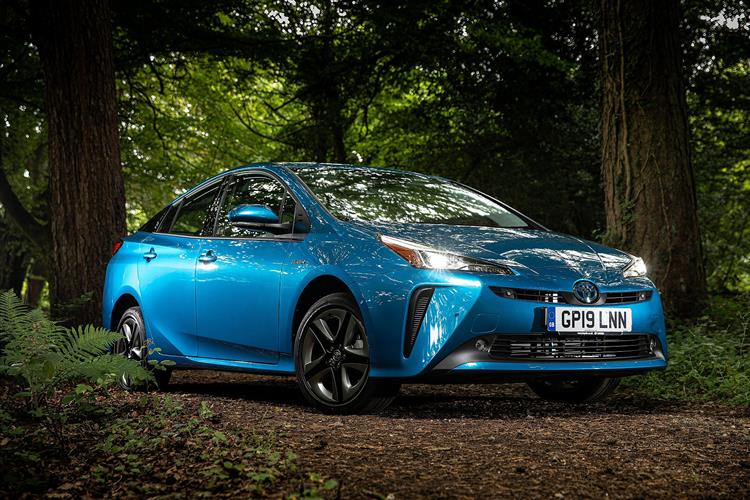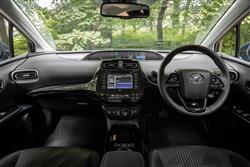How will you view?
This is a sample, showing 30 seconds of each section.
A SENSIBLE STATEMENT (some text hidden) SECTIONED_new_toyotaprius_2016
By Jonathan Crouch
Introductionword count: 87
Toyota's Prius is the most recognisable hybrid vehicle on our roads, but was very different in this fourth generation guise. There was a sleeker, more striking shape made possible by a stiffer, more sophisticated platform that helpws to substantially improve the handling. The hybrid powertrain was cleverer too, hence a set of efficiency returns that once more established this car's superiority over comparably-priced diesel rivals. In short, this car was thoroughly rejuvenated. Here, we check out earlier versions of this 'XW50'-series MK4 model as a used buy.
Modelsword count: 14
5 door hatch (1.8 Hybrid - petrol) [Active, Business Edition, Business Edition Plus, Excel]
Historyword count: 678
Welcome to the car that in its first two decades of life re-shaped the global automotive landscape, bringing hybrid technology into the mainstream market, while focusing the motor industry's attention on the way its products could be cleaner and more efficient. Toyota's Prius did all that and in this rejuvenated MK4 model guise, aimed to continue to set those standards, building upon quite a heritage of ingenuity. To understand it, we need to turn the clock back to 1994 and a year in which the Toyota Motor Corporation made a decision aimed at fundamentally changing the way the world would drive. Engines, until that point exclusively fuel-based, could, the company decided, be developed in future to run with a combination of fuel and battery power. This so-called 'hybrid' solution would double efficiency, slash harmful emissions and create a whole new class of car. So was born the Prius, the world's very first mass-produced hybrid-powered vehicle, a model true to the Latin roots of its name in being very much 'ahead of its time'. So familiar are we with hybrids today that it's easy to forget how ground-breaking this technology was two decades ago. It certainly took Toyota a while to get it right, early prototypes catching fire, failing to start or merely silently expiring after just a few miles of use. But Chief Engineer Takeshi Uchiyamada and his 'G-21' development team persevered and by early 1997, the very first Prius model was ready for launch, a dumpy rather awkward-looking saloon that suited the Japanese market but rather puzzled everyone else. Toyota lost money on every one sold - but they weren't put off. The world would have a hybrid: it was simply a matter of time. And public perception - which began to change when movie stars like Leonardo DiCaprio, Cameron Diaz and Harrison Ford all became Prius people. Drive this car and it was clear to all that you cared about your world and its future, a statement that, as it turned out, a lot of people wanted to make. So many in fact that suddenly, what had begun as something GM's Vice Chairman described as 'an interesting curiosity' became a 'must-have' eco-fashion accessory, especially when a larger, more stylish second generation hatchback version was introduced in 2003 with significant gains in power and efficiency. 'You look smart: you should drive a Prius' the advertising told us - and very soon, millions were doing just that, the model's mass-market success sealed with the launch of a third generation version in 2009 that used a more efficient hybrid system and switched from 1.5 to pokier 1.8-litre petrol power, yet was still cleaner and more frugal. By now, Toyota was ready to roll out hybrid technology across all its mainstream products - and share it with its Lexus luxury brand. As a result, by the end of 2015, the corporation had sold over eight million hybrids, 3.5 million of them Prius models. A success story then - to a point. For all its notoriety, the Prius remained a niche market choice in its first three generations of life. A great option if you wanted to demonstrate your concern for the Polar Ice Cap, but too compromised in handling and practicality to interest most mainstream family hatch folk. The suspension lurched through the corners. The CVT auto you had to have was thrashy. And the batteries took up boot space. What kind of car would this Toyota be if these things were sorted and the Prius brought up to date with a younger, more dynamic image, we wondered? Could it be made efficient enough to out-class a fresh generation of eco-minded diesel rivals? And would Toyota match its environmental credentials with an equally impressive showing in the fields of safety and connectivity? These were the questions this MK4 model was pretty successful in addressing, the car launched in the early Spring of 2016. It sold in its original form until mid-2019, when a lightly facelifted version was introduced, but it's the pre-facelift 2016-2019-era MK4 Prius models we look at here.
What You Getword count: 372
The appearance of a Prius must not only be instantly recognisable but also aggressively futuristic. That is, after all, the whole point of it. Were you to want this technology packaged more conventionally, you'd be looking at one of Toyota's more ordinary models - a Yaris, an Auris or a RAV4. Here, in contrast, is the poster child of the eco revolution, complete with its familiar styling cues - the trademark arching roofline, the slab sides and the double rear screen. Yet somehow, with this MK4 model, it was different, the concept behind this car reinvented for the modern era by a team of young Japanese designers who set out to make it look more powerful, engaging and sporty. Inside, committed Prius people will find the cabin much the same - yet very different. As with previous models, there are no dials to view through the three-spoke steering wheel: instead, the instrument cluster retains its position top and centre on the dash, in this case made up of a couple of 4.2-inch TFT colour screens. Anything this can't tell you will probably be dealt with by the 'Toyota Touch 2' media screen that sits a little further down on the centre stack, just below the neatly-branded air vents. Enough with the various screens: what about the design? The lower bonnet and the deeper windscreen mean that forward visibility is certainly better than in the past. Otherwise, as usual with a Prius, it all feels very different, with the layered dashboard as ever prioritising distinct control and display zones. Taking a seat in the rear is a process that, unless you're really quite short, will involve the need to duck below the sloping roofline. Leg room here is generous and, thanks to the low central transmission tunnel, it's easier to seat three folk than would normally be the case in this size of car. And out back? Well with previous Prius models, the batteries took up cargo room but they were redesigned here to be more compact and this, along this MK4 version's revised rear suspension and more compact hybrid system, meant that boot space on this 'XW50'-series design rose by 56-litres to a 502-litre total, 343-litres of it below the window line.
To see the full road test text contact us on 0330 0020 227
Pictures (high res disabled)

.jpg)
|
.jpg)
|
.jpg)
| |||
.jpg)
|
.jpg)
|
.jpg)
| |||
.jpg)
|
.jpg)
|

|
Scoring (subset of scores)
Category: Hybrid, Plug-in, Electric & Hydrogen
| Performance | |
| Handling | |
| Comfort | |
| Space | |
| Styling, Build, Value, Equipment, Depreciation, Handling, Insurance and Total scores are available with our full data feed. | |



